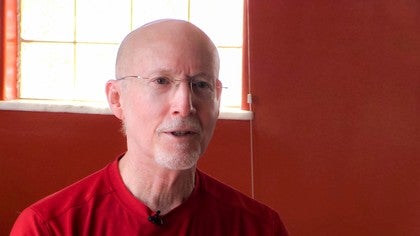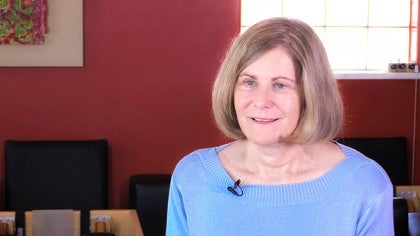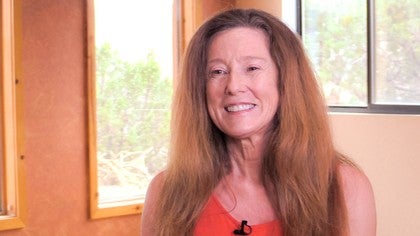Discussion #1486
Dr. James Auerbach on Eve
Description
About This Video
Transcript
Read Full Transcript
My name is Jim Auerbach. I'm a dermatologist in Santa Fe, New Mexico, and I've been here since 1976 and I met eve probably in the late seventies or the early eighties. I saw her in the office and uh, we started talking about what she did and, uh, she told me about her PyLadies and I having been an exercises since 15 and blowing my back weightlifting when I was 15, I was very interested, uh, back when I hurt myself in the 1950s. You were told never arch your back, never touch your toes, never do this, never to that. Consequently, a short term problem becomes a lifelong problem. And, uh, despite limitations, I studied judo in the 60s and what's called Kempo karate in the 60s. Constantly dealing with back issues. And when I met Eve, uh, she wonderfully mentioned the fact, no, no, no. There are lots of things you can do to move your body and regain, uh, mobility and function. I didn't study with her per se. We talked, I went to her studio and got some ideas and uh, time was a limitation then.
And then I eventually had back surgery, uh, which fixed the disc, which then allowed me to do a lot more things. She had a wonderful, uh, understanding of reality that you have to move your body to maintain the function and there are safe, gentle ways of doing it, uh, as opposed to going to the gym and sitting in a seat and counting to 10 over and over while your doing very, uh, uh, limited exercise with very, uh, uh, minimal range of motion. The, the essence of [inaudible] and the circular strength training for, for my understanding is it's all structure, breath and motion. Same with Yoga, same with tie, cheat. Every move, every way we stand every way we sit. If you are focused on, you know, appropriate posture, your structure is uh, using your skeleton for support, not your muscles.
You are breathing appropriately. You can move gracefully and elegantly. And uh, my instructor, Scott, you know, he said the basic goal is to make whatever your physical activity is effortless. And I think if you ever saw eve gentry move, even when she was quite old, she was effortless, graceful, mobile, flexible. And to have that picture in your mind and say, Gee, I want to move like that. My whole life is something that is a, I think, a wonderful goal and makes your body work.
I don't recall her speaking that precisely in terms of little movements and things, but I do remember when she was helping me with my back and we were talking about structure and standing up straight. And I think one of the things she said was, uh, instead of standing up straight, she said, just lift your groin and niche. And if you think about it and you just stand there and think I'm lifting my groin, you simply stand straight. And it's not, uh, a thought that would come to most people naturally. But you instantly relax and you don't get a, a stilted view of how to hold your head or your neck. And, uh, uh, as you know, working with people, if you, if you use cues like, you know, stand up straight, you get almost like a wooden soldier or you get a hyper extended neck instead of relaxed, uh, appropriate posture. So that's an example. I think that was the one, one small movements she told me that I have used. Uh, she did, I'm not sure she told me this one. And another one I like is stand, pretend you're holding a tennis ball under your Chin to lift your crown to keep a nice, uh, neck and spine structure because, uh, I'm sure you've run into it when you say, you know, uh, Tuck your chin. People will either go like this or they'll do weird things with their head.
And the sort of, the image of, of holding a ball there puts people, but usually in the right posture. When you ask me why I recommend people go to see eve, first of all, she didn't hurt people. I had seen people who had had personal trainers or physical therapists who basically had a sheet of exercises and everybody, if you had x, you got y. And I would see people, uh, go to licensed therapists and hurt themselves. And Eve was totally focused on the mechanics of the person she was talking to.
And she would look at them and be able to see where there were problems and limitations. And recommend appropriate, uh, movement that was safe, uh, and would allow them to improve. And so I never worried about referring people to her. I have lots of elderly patients who I'll ask about their exercise and they go, oh, I go to the gym all the time. And well, what do you do? Well, you know, I sit in a chair and I do this and I sit and I pushed this and um, uh, and I go religiously, 45 minutes, twice a week. And what I got when in talking with eve and what I tell people, you don't have to do that. You can, you can stand at the kitchen counter with your hands on the counter and articulate your spine and your hips. You can use your chair in front of the TV to do up a perfectly aligned squat a couple of times during the, whether you integrate your motion, do your neck circles while the tee water's boiling.
And Eve also we talked about that you incorporate what is therapeutic motion, but it's therapeutic for everybody in your daily structure in motion. It's not, well, it's the 45 minutes, twice a week if I'm not too busy and don't show up. Yeah. So that was her big thing was, you know, a little bit here, a little bit there throughout the day and you end up with a much better function. The other thing that I found very interesting when you talked about bones, because Bilott is exercise, they never really talked about bones. Eve took the discussion into the, the arena of bones to try and basically release muscle spasm and pain. And it's interesting that that's what you picked up on with her is it's the alignment of the bones and the muscles then act properly as versus we will contract these muscles and drag the bones along. Right.
When you ask about, uh, or mentioned that eve started talking about skeletal structure as opposed to just we'll flex this, strengthen that. Um, absolutely. And uh, and this also some of the stuff that we talk about in the circular strength training, that when you've properly aligned your structure, the muscles act as a, uh, wonderful rigging to keep what are, are basically unstable self, upright. And, uh, the old anatomy of muscles and function that I was taught as a d in medical school and you were probably taught of we've got our skeletons and the muscles are like pulleys and they work this way. And that was, you know, the study of, you know, dried out, desiccated dead bodies. And, uh, even I didn't talk about this, but you in recent years understanding the myofascially system that, you know, the Fascia that they used to dissect off and throw away when you did anatomy as something that just interfered, was really essential for how you move and how the body operates. And also how we're wired, you know, up one side and across into the other and how the body is not, you know, a bicep and a tricep. But it's this unified, uh, coordinated whole. And in my, uh, dealings with eve, you know, she talked about that too, that, you know, we're not interested in, in a body part. It's the functional whole and everything that, that I tried to do in my personal training and in my teaching is that, you know, we're one coordinated, uh, moving structure and it should be effortless and elegant. It, the other thing that, that I just have a personal dislike for is the current popularity of, Oh, I'm working my core. People say this all the time, and my comment is, well, you should always work your core with everything you do. It shouldn't be, I'm going to isolate, you know, my paraspinal muscle and I'm going to work it.
And I've seen people hurt themselves because they were going, well, I'm trying to strengthen my core and they ruined their backs or their knacks. So to me, every good exercise, every good physical activity, whether it's tennis or football or Yoga, you're working your core naturally. If your structure, breath and motion are being attended to. When you met eve, she was,
I'm not sure. He just in the, in the sense that, um, uh, my whole family has been very long lived in, you know, people worked into their seventies, eighties, 90s. I got an uncle who's 101 this in August. He still works. And also back in my old, uh, Campo days in the 60s, uh, you'd meet some old Chinese Tai Chi practitioners from China town who were supple and graceful and strong. So from, you know, my whole, you know, ever since adolescence, I knew lots of quotes, old people. So Eve was wonderful and physically, uh, inspiring. And so it wasn't, oh, how could this be? It was not only can this be, but she can help other people do it too. You know, I didn't know much about [inaudible] and Palladio's had not become as well known then. But no, I sent, I sent, uh, people to eve, uh, because having talked to her, having seen her studio and how she addressed me, cause she, she spent some time with me kind of helping me understand, you know, my structure, my emotion, how to, you know, minimize pain and recover from injuries. Uh, she was an artist at evaluating people and coming up with good recommendations.
So it wasn't the system, it was eve herself. Uh, that got me to send people to see her.





You need to be a subscriber to post a comment.
Please Log In or Create an Account to start your free trial.